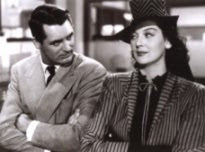Judy and Dino played the Radio City Music Hall during the summer of 1960
The
Museum of Modern Art remembers what Columbia Pictures (now enveloped by
Sony) seems to have regrettably forgotten, namely that Judy Holliday
was terrific - and bracingly idiosyncratic for a Movie Star. Holliday was one of several companionable blondes who played and flirted with audiences during the 1950s. No two were alike. There was Marilyn, of course, the child-woman. And Kim, the haunted blonde. (No need for last names here, right?) And Jayne and Mamie and Sheree, the latter brought in by Fox executives to keep Marilyn in line, a toxic decision that limited the talented Sheree North's career. And then there was Judy, who was less sexualized than the others and, because of that, more accessible.
She also reflected a complicated comic styling, bringing affecting pathos to dialogue meant to be funny. Her singular line readings took her characters precariously close to being pathetic but her uncanny timing rescued her women, keeping their dignity intact and revealing them to be actually kind of smart.
No ditz she.
As a star, Holliday enjoyed a brief two-decade career, which ended prematurely in 1965. She was 43 and she succumbed to breast cancer. Twenty years earlier, she replaced Jean Arthur during the out-of-town tryouts of the Garson Kanin comedy, "Born Yesterday" and subsequently starred in the 1950 Columbia Pictures film version, winning an Oscar. As well as a Columbia contract.
The studio's head, Harry Cohn, initially had no interest in casting the untested Holliday in the film but Kanin and the film's director George Cukor convinced Cohn by first casting her in another collaboration.
That would be MGM's "Adam's Rib."
It was ingenious plan. It worked. Holliday's scant film career consists of six Columbia titles bookended by two Metro films - Cukor and Kanin's aforementioned "Adam's Rib" in 1949 and Vincente Minnelli 's "Bells Are Ringing," based on the hit 1956 stage musical she headlined at the height of her stardom. The film version, released in 1960, was her final movie.
It is also her only film shot in color. Judy Holliday was a black-&-white leading lady and the six films she made for Columbia come with a gray, overcast appeal, most of them filmed (or located) in a woozy New York of another time, a city that paired well with Holliday's distracted personality.
Given
that she made only a half-dozen films for Columbia, it's disappointing
that Sony has yet to combine those titles in a boxed DVD/BluRay set.
But for the time being, there's MoMA's Modern Matinees: Summer with Judy Holliday (curated by Anne Morra), which has been running since late July and continues through August 31st .
Judy & Jack Lemmon & New York in "It Should Happen to You"
At Columbia, between 1950 and 1956, Holliday worked with the venerable Cukor three times ("Born Yesterday," the prescient farce "It Should Happen to You" and the excellent dramedy "The Marrying Kind"); twice with Richard Quine, arguably Columbia's best house director ("The Solid Gold Cadillac" and "Full of Life"), and Mark Robson (the eternally modern and sophisticated - and criminally underrated - "Phffft!").
"Bells Are Ringing," already presented on July 27th, screens again at Moma on August 12that 1:30 p.m. I hope to be there. It would be great to see this Minnelli musical on a big screen again.
It's a fascinating movie because one can sense that Minnelli was aware of changing moviegoer tastes and that, sadly, screen musicals were no longer a welcomed treat. As an act of accommodation, Minnelli made some shrewd changes in the Adolph Green-Betty Condom-Jule Styne material (note his filming of the "I Met a Girl" number" and his reinvention of "Mu-Cha-Cha"), creating a new-style movie musical for its time.
I just wish Vincente had filmed it in black-&-white. You know, for Judy.
Who, by the way, had an IQ of 172. No ditz she.
Note in Passing: While all of Holliday's Columbia films were shot in black-&-white, the final scene of Quine's "The Solid Gold Cadillac" was photographed in color, to accentuate the glittering title vehicle.





















5 comments:
Judy rocks, Joe! Thanks for this.
I saw Bells Are Ringing the day it opened at the Music Hall. My mother was a huge Judy Holliday fan, having seen her in both Born Yesterday and Bells Are Ringing on stage. I wish I had saved all those little Showcase programs they gave out at the Hall, which were only 8x11 pages folded in half, but they contained a lot of credits and information, including what would be the Music Hall's next attraction on the back page. Does anyone remember a movie series that played on local channel 2 in New York called Schaefer Award Theatre? It was only on about ten times per year and always the night before a holiday. That's where I saw Born Yesterday for the first time in it's television debut.
Kevin- Radio City. That's where I first saw "Bells Are Ringing." I still have the little program which you reference. In fact, I have a rather large collection of Radio City programs. The place - as a movie palace - is much missed. -J
Thanks for this Judy Holiday piece. I remember the first time I went for a passport. It was in 1964 in Rockefeller Center and they had celebrity passport photos up (try that today!) and there was a big passport photo of Judy Holiday with her son in the photo.(In those days you could have two people on passport -- I had one with my then husband!) I'll never forget that. How could I? I was going to Paris for the first time.
This is the best analysis of Judy's on-screen persona that I've read. Thanks, Joe.
Post a Comment